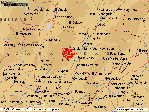 Range of Pinus maximartinezii (3). Locations shown are approximate; see Perry (4) for details on the difficulties of finding these pines in the wild. Adapted from a map by www.expediamaps.com | Pinus maximartinezii Rzedowski 1964Common NamesMartínez piñon (2).Taxonomic notesType: Zacatecas, Sierra de Morones, W of Pueblo Viejo, 25-Jan-1964, Rzedowski 18258 (holotype, MEXU) (5). Allied to P. pinceana and a little less closely to P. rzedowskii.DescriptionA tree to 16 m tall and 40 cm dbh (6). Bark smooth pale grey at first, becoming thinly scaly grey-brown on mature trees. Crown broad, with irregular branches. Leaves blue-green, in fascicles of 5, sheath mostly deciduous but the small basal sheath scales persisting; 6-12 cm long, about 0.8-1 mm thick, with white stomatal bands on the inner faces and a glossy green outer face. Cones huge, massive, pendulous on surprisingly slender peduncles 1-3 cm long and only 6-8 mm thick; oval-cylindric, 14-23 (-26) cm long, 10-12 cm broad, green ripening pale brown and opening to 11-14 cm broad; up to 2 kg when green (4). Scales massive, 35-50 mm broad, 20 mm thick, apophysis pyramidal, with an unarmed knoblike 10-15 mm wide umbo. Seeds very large, 22-26 mm (the largest of any pine), orange-buff, wing 1-2 mm, vestigial, remaining attached to the scale when seed removed (5, 6). Seeds do not fall naturally from cone, but are dispersed by birds (2). Cones mature in August, about 27-28 months after pollination (6; from conversations with villagers in Pueblo Viejo), an unusually long period. Seedlings have up to 24 cotyledons on germination (the most of any plant), and continue to produce juvenile foliage only for several years, with nodding white shoots and single 3-4 cm leaves, strongly glaucous.RangeMexico: S Zacatecas, from ca. 12 km SW to a few km W of Juchipila. It is found in scattered stands across an area of about 5-10 km² on ridges and E-facing slopes of the Sierra de Morones (3), in montane dry forest at 1900-2200 m altitude (4). USDA hardiness zone 9.Big TreeOldestDendrochronologyEthnobotanySee Remarks.ObservationsSee Perry (4) for details of access; the best trees with the largest cones grow at higher altitudes on the Sierra; low altitude trees are stunted by drought and only bear smaller cones (6).RemarksListed by the World Conservation Monitoring Centre - Trees database as endangered. The WCMC list notes that "A total population of fewer than 10,000 trees exists... Regeneration is poor, possibly because the seeds are collected in considerable numbers for food. Cattle grazing and fires also pose threats. The land is privately owned but formal protection measures are being considered."A very attractive tree. In cultivation under glass, leaves up to 23 cm long may be produced. Citations(1) Silba 1986.(2) Lanner 1981. (3) Farjon & Styles 1997. (4) Perry 1991. (5) Rzedowski, J. 1964. Una especie nueva de pino piñonero del estado de Zacatecas (Mexico). Ciencias (Mexico) 23: 17-20. (6) M.P. Frankis, field notes, NE Mexico, November 1991. See also: Donahue, J.K. 1995. Observations on Pinus maximartinezii Rzedowski. Madroño 42(1): 19-25. The Nature Conservancy. 1996. Natural Heritage Central Database. (Status and distribution data on Latin American plants, developed in collaboration with Latin American Conservation Data Centers and Missouri Botanical Garden.). Vovides, A.P. 1981. Lista preliminar de plantas Mexicanas raras o en peligro de extinción. Biotica 6(2): 219-228. Description prepared by M.P. Frankis, Jan-1999. |
[Pinus] [Pinaceae] [home] This page is from the Gymnosperm Database |